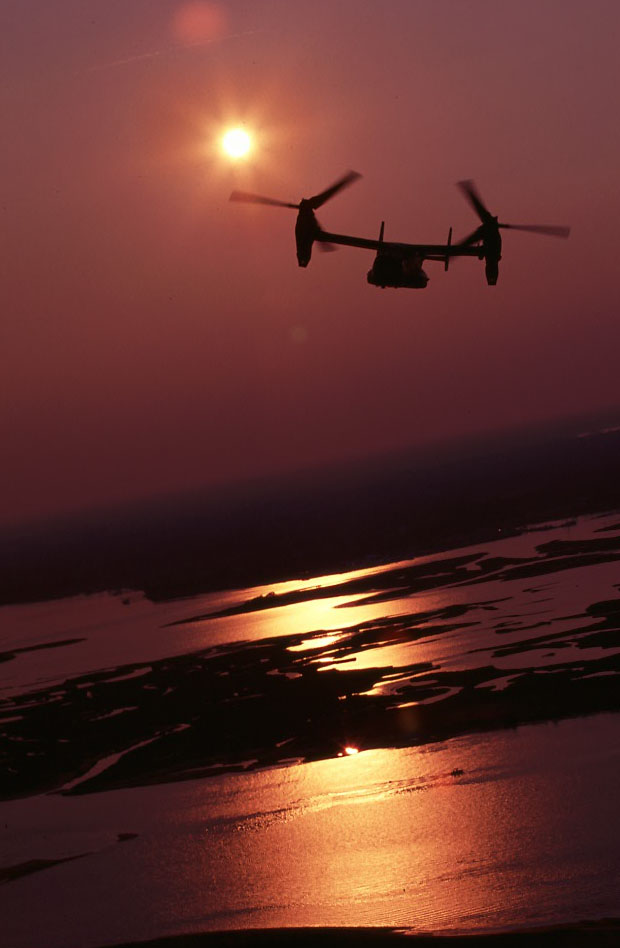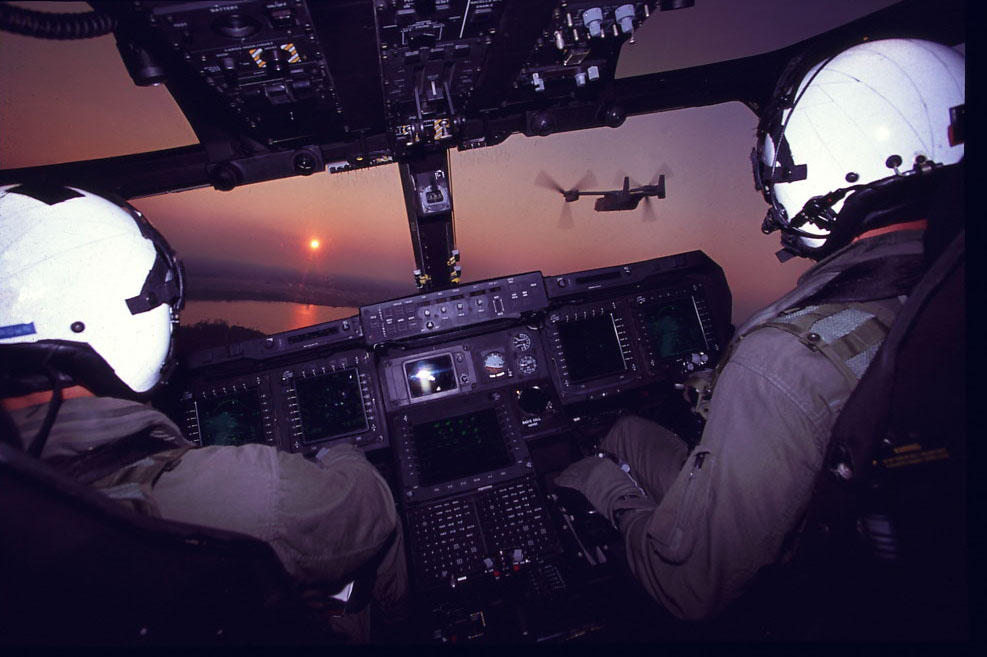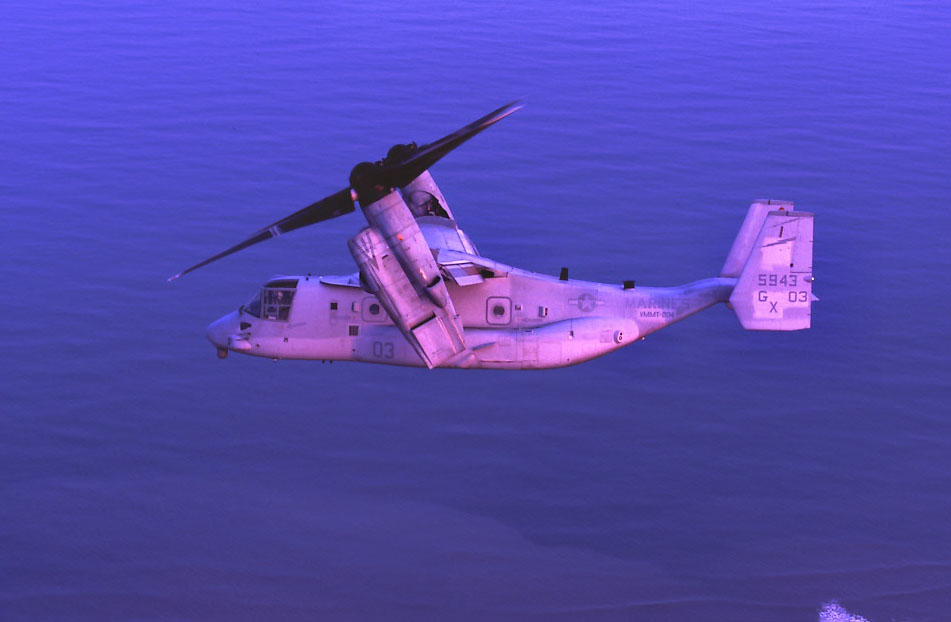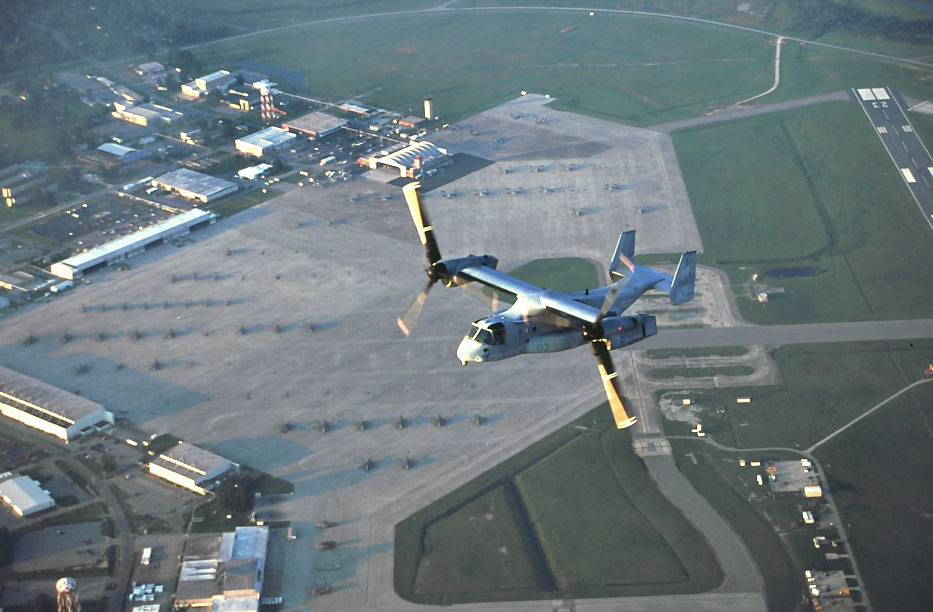
The revolutionary Bell Boeing tilt-rotor V-22 Osprey combines the capabilities of fixed wing aircraft and helicopters into a truly unique combat aircraft. Upon close inspection, it is nothing short of an engineering marvel. To say the Osprey is cutting edge would be an understatement. The vision of the V-22 began over twenty years ago with the United States Marine Corps which have never been shy in introducing new technology to meet their unique needs. Like the AV-8 Harrier Jump Jet the Corps first introduced to the American arsenal, the V-22 operates in both vertical and traditional flight regimes, the combination of which in a single platform provides unique engineering challenges.
The Ospreys engine nacelles and large rotors can rotate to allow the aircraft to conduct flight operations in the vertical helicopter mode, than transition in conversion mode to that of a fixed wing airplane. No aircraft offers the capabilities to fly in various flight regimes like the Osprey. Introducing cutting edge technology is not without risk, and the Osprey underwent a difficult teething process but is now considered safe for flight and operationally deployable. The Osprey is jointly produced by Boeing Rotorcraft Systems which makes the fuselage and all subsystems, digital avionics and fly-by-wire flight controls. Boeing partner, Bell Helicopter Textron makes wing, transmissions and rotor systems and installs the engines.
The V-22 is a true multi-service aircraft planned to serve with the Navy, Air Force Special Operations Command and Marine Corps. Senior U.S. Marine Corp officers comment that the Osprey will change the way they fight. The aircraft is dubbed 'transformational' offering assault support capabilities not currently available. Compared to the CH-46 and CH-53D helicopters it is replacing, the Osprey can carry three times the payload, travel at twice the speed and five times further than the aging Marine helicopters. These attributes, along with in-flight refueling capabilities, an internal ramp gun and cutting edge avionics make the Osprey far more survivable, and lethal.
Currently there are three main versions planned for the Osprey. The MV-22 will be operated by the Marine Corps in the medium assault role, the CV-22 by the US Air Force Special Operations and the HV-22 by the US Navy which will use the aircraft for combat search and rescue, special warfare and fleet logistic support.
Deputy Commandant for Marine Corp Aviation, Lt. General John Castellaw confirms the MV-22's revolutionary impact on Marine Air Combat Element capability "With Marine Medium Tilt-rotor Squadron (VMM) 263 standing up in March of 2006 and preparing to thunder into combat next year in MV-22 Osprey's, medium assault as we know it will be changed forever."
Painful Teething Process

In 2002 the Osprey program returned to flight status after an 18 month hiatus that followed a tumultuous period in which numerous aircraft where lost as well as valuable lives. While it can be argued that the price of progress in military aviation comes at the expense of blood and treasure, the losses were significant and highly visible. Changes needed to be made to the aircrafts design, the management of the program and within the test and evaluation process the Marines employed.
An independent incident review board was formed after the devastating crash of an Osprey at MCAS Yuma in 2000 to provide a detailed analysis as to the cause(s) of the crash and offer recommendations. After significant analysis and with the concurrence of a secondary board consisting of individuals from NASA it was determined that additional testing and training was needed particularly concerning a phenomenon called Vortex Ring State or VRS. It is loosely analogous to a low speed high angle of attack maneuver by a fixed wing aircraft. Not unique to the Osprey, the VRS occurs when a rotary aircraft (V-22 or helicopter) descends at a high rate of speed with little or no forward movement. The rotor, which provides all the lift, is already moving in a downward manner through the turbulent air it is beating loses lift and stalls. A second rigorous operational evaluation (OPEVAL) was conducted by VMX-22 in 2005. In September 2005, the Department of Defense approved the Osprey capable of meeting all stated requirements and safe for production.
Marine Osprey

The Marines are planning on deploying a total of 360 Osprey's in three distinct variants, the MV-22 Block A, B and C. Currently, all A models will strictly serve within the FRS training units. The Block A aircraft compared to previous test designs incorporates numerous improvements including a redesign of the nacelles, for safety as well as numerous software upgrades to the flight control and power management systems. The B model will have an enhanced maintainability nacelle s well as numerous addition improvements. These will include a retractable fuel probe for in-flight refueling, a ramp gun and various avionics, communications and navigations upgrades. Current preplanned product improvements for the Block C aircraft include; flight incident recorder, weather radar and electronic countermeasures upgrades improved interior and exterior lighting and a redesign of the main gear brake.
The USAF CV-22 Block 0 and l0 aircraft will be similar to the MV-22. The CV-22 Block 0 will have a 90% airframe, 50% and 100% commonality with the Marines Osprey. The follow on variant however will be distinctly different from the avionics standpoint. The Block 10 bird will be outfitted with mission enhancing systems including a TCAS (Terrain Collision and Avoidance) system as well as Flight Engineers displays.
Boeing Communications Manager Jack Satterfield notes "To date, the requirement remains for 360 MV-22's for the US Marine Corps, 50 CV-22's for the US Air Force Special Operations Command and an unfunded requirement for 48 HV-22's for the U.S. Navy. Boeing continues to produce fuselages and Bell adds wing, tail and delivers from their facility in Amarillo, Texas. We had a very successful demo at Farnborough and Royal Air Tattoo in the UK. This has generated significant international interest in the Osprey. If we move through multi-year as planned, we expect to reach our target cost of $58million for an MV-22 by 2010, with no changes in the current buy. We will deliver 78 aircraft this month (August, 2006), so that tells you we are in the program. We are gradually ramping up our production rate, which ultimately will depend on the budget that is made available. We believe we can count on at least 30 MV-22's a year at the maximum rate, along with between four and six CV-22's. We currently are delivering Block B aircraft, which are fully operational. Block C is in planning and will add several additional capabilities that will enhance future operations."
The Osprey will carry twenty four Marine combat troops or 20,000 pounds of cargo. The Osprey will be more survivable than the CH-53D or aging CH-46 by virtue of its increased speed and the altitudes it can operate. The Osprey provides much greater range and flexibility than either helicopter platform and is capable of in-flight refueling from Marine KC-130 Hercules aircraft.

Currently, the Marines have twenty nine A models with their Fleet Replacement Squadron, VMMT-204 based at MCAS New River. The squadron is responsible for training all V-22 aircrews and maintainers. The first operational Marine Osprey squadron, the 'Thunder Chickens" of VMM-263 was recently activated. The plan for the unit includes deployment in support of Operation Iraqi Freedom as part of the 22nd Marine Expeditionary Unit. The unit will deploy with a full compliment of MV-22B Ospreys. A total of twenty two fleet and three support squadrons will be outfitted with at least twelve aircraft each. The transition plan for CH-46 and CH-53D units will take place in the following order: East Coast, West Coast, Okinawa then Hawaii. Currently HMM-162 which stood down in December of 2005 has trained alongside VMMT-204 and in September 2006 will stand up as VMM-162.
Major Rob Freeland, one of the VMMT-204 instructor pilots discusses the make up of the unit, "Our instructors come from the following legacy aircraft, (17) CH-46, (5) CH-53, (4) AH-1W, (1) UH-1N, (1) FA-18D, (1) AV-8B, (1) EA-6B, (1) HH-60B, (3) Pavelow and (1) Pavehawk. In addition, our instructors come from the three services with the vast majority (30) from the Marine Corps, (1) from the Navy and (4) from the US Air Force. Our USAF students come from both Rotary Wing and Fixed Wing communities."
Commenting on flying the Osprey and the training 204 delivers Major Freeland notes "We are a turboprop that can hover, and we train with that in mind. Although we need to spend some time in the bounce pattern giving the students a chance to train their thumbs (manipulates the nacelle wheel to change the angle of the nacelles; the fundamental difference between FW, RW, and tiltrotor), we push a great deal of our training to higher altitudes. The challenge (and exciting part, really), is to transition from the higher altitudes to a landing zone or to low altitude tactics flight."
The author is grateful to the following individuals for their support with this story Lt. General John Castellaw, Colonel Joel Kane, Lt. Colonel John Vara, Lt. Colonel Anthony Bianca, Major Rob Freeland, Lt. Colonel Scott Fazekas, MSgt Phil Mehringer, Mr. Carl Erlandson, SSGT Chris Pesapane, Captain Jerome Bryant and Jack Satterfield (Boeing).
Interview - Major Rob Freeland, VMMT-204 - Former Operations Officer and CH-46 pilot.
Q: Overall description of flying the Osprey.
A: Flying the Osprey is a real kick in the pants and a great deal of fun. The acceleration of the aircraft is so good that our ability to get to altitude and airspeed is very strong. We can also change states very quickly so going from high airspeed and altitude in airplane mode through conversion mode down onto the deck in full rotary mode happens very fast. We can combine the fuel efficiency and long range of a turboprop with the maneuverability of a rotorcraft.
Q: Compare the MV-22 to the CH-46 it is replacing.
A: To a certain extent comparing the MV-22 to the CH-46 is a bit like comparing apples to oranges. With the CH-46 you can quickly land on the exact spot you just flew over a moment ago at 120 knots. The CH-46 is quicker in moving around to a landing zone from inside a half mile away. The MV-22 however, is much quicker getting to that spot from many miles away than the CH-46 based on its enhanced speed. With the Osprey we can also get in with much less noise and the enemy would not have as much notice of our arrival because we are quieter. I did notice that the brown out condition our pilots experience while landing in desert conditions is less challenging in the MV-22 compared to the CH-46 (a condition where the dusk kicked up by the rotor wash creates a situation whereby the pilot loses sight of the ground). This is largely due to the rotor-wash of the MV-22. With the CH-46, you might incur a complete brown out at fifteen feet and not regain visibility of the ground until you are five feet off the deck. With the 22, brownout begins at a higher altitude but you regain your sight picture of the ground while at a higher altitude, typically 15 to 20 feet above the ground. While it may look like a huge dust cloud from outside the Osprey, the rotor-wash is so strong that visibility for the pilots is good, making operations safer.
Q: How does the Osprey handle specific aspects of flying such as refueling, formation flying, Night Vision Goggles, shipboard operations?
A: It easy to keep station on other aircraft while flying in formation in the Osprey. This is largely due to the automation of the digital flight control system. Initially there was some concern that formation flying might be challenging due to the high task loads on the aircrews that is faced by the rotary community, but this has not been the case at all. Similarly refueling in the Osprey off Marine Caps KC-130's is very easy. The MV-22 is very smooth and once in a level platform it is easy to get positioned laterally and horizontally it is simply a slight power input to engage the basket. Unlike the CH-53, there is no cyclic input, just need to simply add power. I have found flying around the boat to be pretty easy as well. The Osprey is so versatile, it can hold above the ship in airplane mode easily and loiter for quite some time. The Osprey burns half the fuel in airplane mode as it does in conversion mode.
Q: What is the most challenging aspect of flying the Osprey?

A: Initially I found shipboard deck landings while flying on Night Vision Goggles (NVG) was a bit challenging especially the rolling of the deck in high sea states. Even in high seas with the deck rolling there is a slight pause of maybe five seconds every half minute which is predictable and is the optimal point to land. The MV-22 requires smaller inputs than other rotary platforms, you don't want to chase the deck and the smooth handling characteristics and tremendous power of the Osprey helps in this regime.
Q: How long does it take a new student to get proficient and comfortable in the Osprey?
A: Having done many aircraft commander flight-check rides I can say it takes between 70 and 100 hours for new guys to get comfortable in the Osprey. This depends on the student of course. The high levels of automation in the Osprey especially with the digital flight controls in particular makes division of tasks easy Osprey aircrews pretty straightforward. For those students coming from slightly more advanced and automated aircraft like the C-130 or CH-53 than say UH-1 or CH-46 aircraft it is a bit easier. With the Fleet Replacement Squadron (VMMT-204) ramping up this is getting even shorter. Systems and tilt-rotor knowledge is climbing within the FRS training program so with new students it is largely a matter of aeronautical experience. The Osprey is unique compared to current rotary and fixed wing aircraft in that it uses a Thrust Control Lever (TCL) which takes the place of a collective in the case of a helicopter or throttle in a fixed wing aircraft. The flight control software that interfaces between the TCL and the engines does all the work and is simply amazing.

